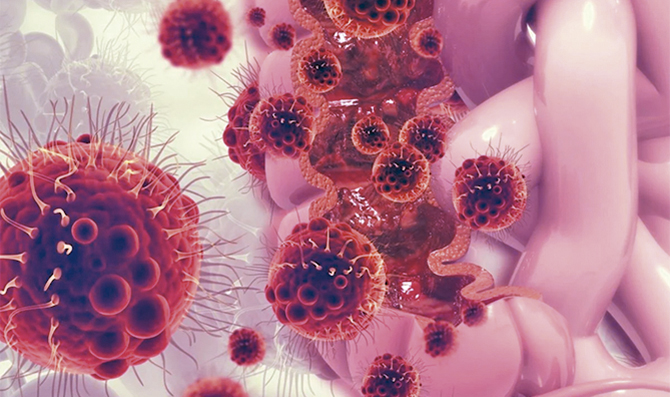Qué son las nanocápsulas, la nueva frontera de la lucha contra el cáncer / What are nanocapsules, the new frontier of the fight against cancer
Las nanocápsulas permiten detectar el cáncer de una forma mucho menos invasiva, con un simple análisis de orina.
Todos hemos sido testigos directos de una de las enfermedades más devastadoras de nuestro tiempo: el cáncer.
Afortunadamente, y gracias a los avances médicos, cada vez se reduce más la tasa de mortalidad de esta enfermedad.
Sin embargo, tanto el diagnóstico como los tratamientos actuales llevan asociados numerosos efectos secundarios como pérdida de peso y apetito, caída del cabello, insomnio, cansancio, etc.
Consecuencias preocupantes porque empeoran considerablemente la calidad de vida de los pacientes hasta el punto de poner en riesgo su salud.
Así las cosas, la ciencia se enfrenta a un importante reto: ¿habría algún modo de detectar el cáncer de manera más temprana y con técnicas más sencillas?
Es más, una vez detectado, ¿sería posible aplicar tratamientos más específicos que minimicen los efectos secundarios?
Caballos de Troya contra el cáncer
Investigadores del grupo de Paula T. Hammond en el MIT de Estados Unidos han desarrollado recientemente unas cápsulas en la escala nanométrica (nanocápsulas) que permitirían simultáneamente detectar el cáncer con un simple análisis de orina y combatirlo a modo de caballo de Troya.
Esto es, penetrando en las células malignas y liberando toda su carga terapéutica en el interior de las mismas.
En los tratamientos tradicionales del cáncer (por ejemplo, la quimioterapia) el agente terapéutico se distribuye a lo largo de todo el organismo, atacando indistintamente a células sanas y células malignas.
Pero, ¿qué culpa tienen las células sanas? ¿No hay ningún modo de atacar exclusivamente a las cancerígenas? La nanotecnología puede darnos la solución.
Las nanocápsulas tienen una tendencia natural para acumularse en las áreas tumorales gracias a un efecto conocido como EPR (Enhanced Permeability and Retention).
Las células cancerígenas crecen rápido y son muy activas, por lo que tienen que fabricar apresuradamente vasos sanguíneos para asegurarse un suministro de oxígeno y nutrientes.
Al igual que un edificio construido de forma precoz, estos vasos sanguíneos tienen imperfecciones en su estructura. Las nanocápsulas que viajan por el torrente sanguíneo aprovechan estas imperfecciones para introducirse y acumularse en el tumor.
Además, para conseguir una acumulación todavía mejor, es posible modificar la superficie de estas nanocápsulas con diferentes moléculas.
Estas moléculas actúan como pequeños sensores que se unen específicamente a células tumorales. Igual que si se tratara de las piezas de un puzzle.
De este modo, se consigue liberar el agente terapéutico únicamente en el entorno de células malignas, sin afectar a las células sanas.
Detectando tumores en la orina
Poder detectar el cáncer con un simple análisis de orina, evitando técnicas más invasivas o caras como la biopsia o las resonancias, parece una realidad cada vez más cercana gracias a los recientes avances científicos.
El ambiente en el que crecen las células cancerígenas es totalmente diferente al encontrado en las regiones de tejido sano.
Éste se caracteriza por bajos valores de pH (entorno ácido) y altos niveles de unas proteínas conocidas como metaloproteasas, que ayudan al crecimiento y propagación del tumor.
Las nanocápsulas desarrolladas en el grupo de Paula T. Hammond llevan incrustada en su superficie una molécula que puede ser detectada en la orina.
Lo realmente interesante es que la unión entre dicha molécula y la superficie de la cápsula es inteligente, de tal modo que ésta se rompe únicamente en presencia de altos niveles de metaloproteasas, liberando la molécula de la cápsula y detectándose así en la orina.
En pruebas con ratones que presentaban tres tipos de cánceres (de páncreas, colorrectal y de ovario), los niveles de esta molécula fueron más altos en la orina de aquellos animales que sufrían cáncer. Objetivo conseguido: las nanocápsulas tienen poder diagnóstico.
Silenciando las células cancerígenas
Lo que hace que las células cancerígenas se descontrolen es que están genéticamente mal programadas.
Presentan genes alterados que provocan la proliferación y el crecimiento incontrolado de las células, generando lo que todos conocemos como tumor.
Los avances en genética permiten hoy en día atenuar la expresión de dichos genes mediante unas moléculas conocidas como siRNA (ARN de silenciamiento), consiguiendo así detener el cáncer.
Sin embargo, para que el tratamiento sea efectivo, estas moléculas de siRNA deben ser liberadas en el interior de la célula cancerígena.
La membrana exterior de las nanocápsulas desarrolladas por el grupo de Paula T. Hammond está compuesta por moléculas de siRNA.
De este modo, y aprovechando su capacidad para acumularse en el tejido cancerígeno y penetrar en células malignas, se ha conseguido liberar este siRNA en las zonas tumorales y silenciar un gen modelo en ratones que presentaban tres cánceres diferentes (páncreas, colorrectal y ovario).
A pesar de tratarse de un trabajo preliminar en animales y con un solo gen modelo, la innovadora estrategia podría abrir nuevas puertas hacía terapias de diagnóstico que incluyen, a su vez, un tratamiento específico para cada cáncer.
En definitiva, la batalla contra el cáncer continúa. No le damos respiro. Lo que parece indiscutible es que, para seguir avanzando hacia terapias más efectivas y diagnósticos más tempranos, es fundamental aunar el conocimiento y esfuerzo de expertos de diferentes disciplinas científicas y tecnológicas.

What are nanocapsules, the new frontier of the fight against cancer
Nanocapsules allow cancer to be detected in a much less invasive way, with a simple urine test.
Tiny capsules developed by MIT researchers can be used to fight malignant cells by penetrating them.
We have all been direct witnesses to one of the most devastating diseases of our time: cancer.
Fortunately, and thanks to medical advances, the mortality rate of this disease is increasingly reduced.
However, both diagnosis and current treatments have numerous associated side effects such as weight loss and appetite, hair loss, insomnia, tiredness, etc.
Worrying consequences because they significantly worsen the quality of life of patients to the point of putting their health at risk.
Thus, science faces an important challenge: Would there be a way to detect cancer earlier and with simpler techniques?
Furthermore, once detected, would it be possible to apply more specific treatments that minimize side effects?
Trojan Horses Against Cancer
Researchers from Paula T. Hammond’s group at MIT in the United States have recently developed capsules on the nanometer scale (nanocapsules) that would simultaneously allow detect cancer with a simple urinalysis and fight it like a Trojan horse.
This is, penetrating malignant cells and releasing all its therapeutic load inside them.
In traditional cancer treatments (eg chemotherapy) the therapeutic agent is distributed throughout the body, attacking healthy cells and malignant cells indiscriminately.
But what is the fault of healthy cells? Is there no way to exclusively attack carcinogens? Nanotechnology can give us the solution.
Nanocapsules have a natural tendency to accumulate in tumor areas thanks to an effect known as EPR (Enhanced Permeability and Retention).
Cancer cells grow fast and are very active, so they have to rush to make blood vessels to ensure a supply of oxygen and nutrients.
Despite the fact that research has only been done in animals, the innovative strategy could open new doors to diagnostic therapies that include, in turn, a specific treatment for each type of cancer.
Like an early-constructed building, these blood vessels have imperfections in its structure. The nanocapsules that travel through the bloodstream take advantage of these imperfections to enter and accumulate in the tumor.
Furthermore, to achieve an even better accumulation, it is possible to modify the surface of these nanocapsules with different molecules.
These molecules act as small sensors that specifically bind to tumor cells. Just as if it were the pieces of a puzzle.
In this way, it is possible to release the therapeutic agent only in the environment of malignant cells, without affecting healthy cells.
Detecting tumors in the urine
Being able to detect cancer with a simple urinalysis, avoiding more invasive or expensive techniques such as biopsy or MRI, seems to be an ever closer reality thanks to recent scientific advances.
The environment in which cancer cells grow is totally different from that found in healthy tissue regions.
This is characterized by low pH values (acidic environment) and high levels of proteins known as metalloproteases, which help the growth and spread of the tumor.
The nanocapsules developed in Paula T. Hammond’s group have a molecule embedded in their surface that can be detected in urine.
What is really interesting is that the connection between said molecule and the capsule surface is intelligent, in such a way that it breaks only in the presence of high levels of metalloproteases, releasing the molecule from the capsule and thus detecting itself in urine.
In tests with mice that had three types of cancers (pancreas, colorectal, and ovarian), the levels of this molecule were higher in the urine of those animals that suffered from cancer. Objective achieved: nanocapsules have diagnostic power.
Silencing cancer cells
What makes cancer cells go haywire is that they are genetically poorly programmed.
They present altered genes that cause the proliferation and uncontrolled growth of cells, generating what we all know as a tumor.
Advances in genetics today allow the expression of these genes to be attenuated by means of molecules known as siRNA (silencing RNA), thus stopping cancer.
However, for treatment to be effective, these siRNA molecules must be released into the cancer cell.
The outer membrane of nanocapsules developed by Paula T. Hammond’s group is made up of siRNA molecules.
In this way, and taking advantage of its ability to accumulate in cancer tissue and penetrate malignant cells, it has been possible to release this siRNA in tumor areas and silence a model gene in mice that presented three different cancers (pancreas, colorectal and ovary).
Despite being preliminary work on animals and with a single model gene, the innovative strategy could open new doors to diagnostic therapies which include, in turn, a specific treatment for each cancer.
Ultimately, the battle against cancer continues. We don’t give you respite. What seems indisputable is that, to continue advancing towards more effective therapies and earlier diagnoses, it is essential to combine the knowledge and effort of experts from different scientific and technological disciplines.


Debe estar conectado para enviar un comentario.